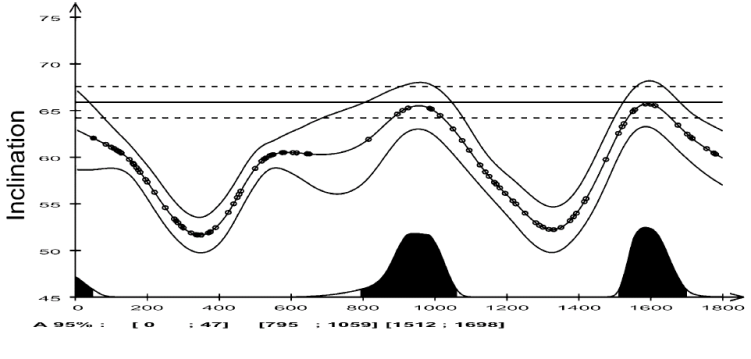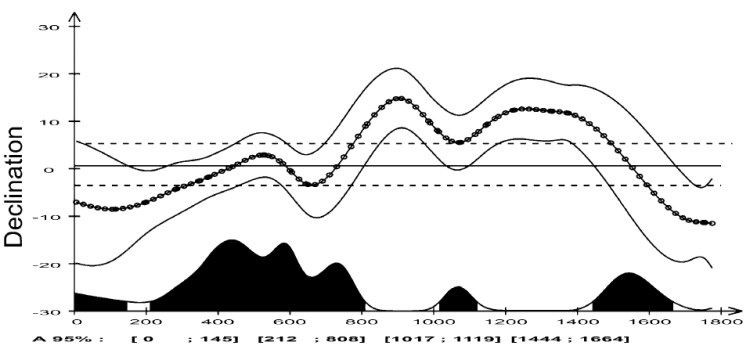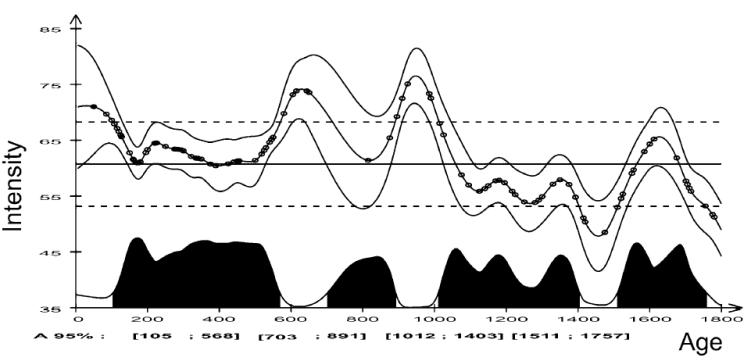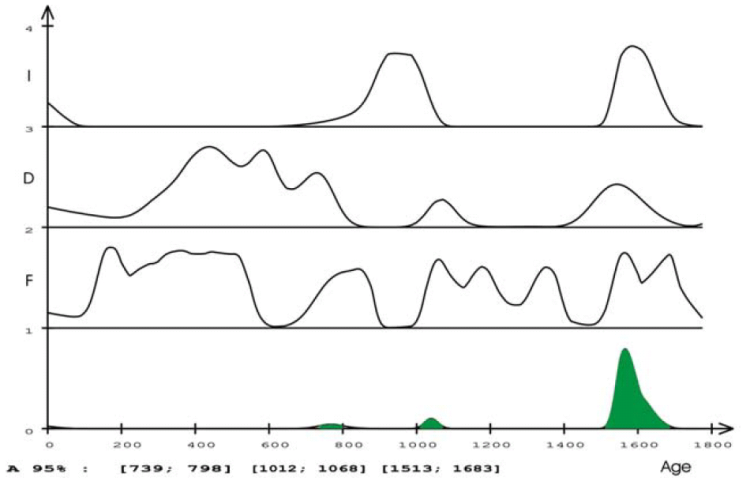What is REN-DATE?
Ren-Date is a
software programme for archaeomagnetic dating. It is relies on Bayesian
statistics, assuming hierarchical sampling and laboratory analysis.
What does REN-DATE do?
Having calculated the mean direction and/or the intensity of an archaeological artefact (strictly following the hierarchy), REN-DATE calculates probability densities of possible dates for each geomagnetic field element, by comparison with a secular variation mastercurve. The archaeomagnetic dating is obtained by combining all probability densities, in order to find the most probable solution.
Example
The measured average remanence direction archaeointensity is:



(from Kovacheva et al., 2004)
Figure B: Probability densities of possible ages for inclination (I), declination (D) and archaeointensity (F). Their combination is displayed in the lowermost diagram (green shaded areas). The highest probability has the last age interval (1513 - 1683) which confirms the supposition of the archaeologists, that this kiln was last in used during the Ottoman Empire.

(from Kovacheva et al., 2004)
Requirements
REN-DATE is available for the disk operating system MS-WINDOWS.
Installation
Unzip the file you have downloaded and follow the instructions on the screen.
Download
file size 1.3 Mb

 *.zip
*.zip
Advice on usage
The files GAL2002D.REF and GAL2002I.REF concern the French secular variation master curve for declination and inclination, respectively, reduced to Paris according to the synthesised data from Gallet et al. 2002. Both files were preliminary calculated using the programme RenCurve, but do currently not take into account the errors in time. For further question please contact Philippe Lanos philippe.lanos@univ-rennes1.fr.
References
Gallet, Y., Genevey, A. and M. Le Goff, Three millennia of directional variation of the Earth's magnetic field in western Europe as revealed by archaeological artefacts, Physics of the Earth and Planetary Interiors, 131, 81-89, 2002.
Lanos, P., Bayesian inference of calibration curves: application to archaeomagnetism, in: Buck, C. & A. Millard (eds.), Tools for constructing chronologies: crossing disciplinary boundaries, Springer-Verlag, London, Vol. 177, pp. 43-82, 2004.
Lanos, P., Le Goff, M., Kovacheva, M. and E. Schnepp, Hierarchical modelling of archaeomagnetic data and curve estimation by moving average technique, Geophysical Journal International, 160, 440-476, 2005.
What does REN-DATE do?
Having calculated the mean direction and/or the intensity of an archaeological artefact (strictly following the hierarchy), REN-DATE calculates probability densities of possible dates for each geomagnetic field element, by comparison with a secular variation mastercurve. The archaeomagnetic dating is obtained by combining all probability densities, in order to find the most probable solution.
Example
The following example
is taken
from Kovacheva (2004) and
concerns one kiln from the archaeological site Serdica that been dated
by coin findings, belonging to the reign of Emperor Justinian II (i.e.
565-578 AD). However, archaeologists suppose that this kiln may have
been in use during the Ottoman Empire.
The measured average remanence direction archaeointensity is:
- Inclination: I = 65.9°
- Declination: D = 0.6°
- confidence
factor: α95
= 2.1°
- confidence parameter: κ = 1285
- Number of samples: N = 5
- Archaeointensity: F = (60.75 ± 5.45) μT from two accepted samples
Figure A: The horizontal solid
lines in the figures below correspond to the measured site mean
inclination, declination and archaeointensity, the parallel dashed
lines correspond to the error. The Bulgarian secular variation
mastercurve is plotted with its errors. The measured geomagnetic field
elements (I,D,F) meet several times the secular variation curve,
resulting in different multiple probability intervals of possible ages (black shaded areas). If the
probability intervals of all three geomagnetic elements are combined (Figure B), the most probable age of the last heating is
1513-1683.
(from Kovacheva et al., 2004)
Figure B: Probability densities of possible ages for inclination (I), declination (D) and archaeointensity (F). Their combination is displayed in the lowermost diagram (green shaded areas). The highest probability has the last age interval (1513 - 1683) which confirms the supposition of the archaeologists, that this kiln was last in used during the Ottoman Empire.
(from Kovacheva et al., 2004)
Requirements
REN-DATE is available for the disk operating system MS-WINDOWS.
Installation
Unzip the file you have downloaded and follow the instructions on the screen.
Download
file size 1.3 Mb
Advice on usage
The files GAL2002D.REF and GAL2002I.REF concern the French secular variation master curve for declination and inclination, respectively, reduced to Paris according to the synthesised data from Gallet et al. 2002. Both files were preliminary calculated using the programme RenCurve, but do currently not take into account the errors in time. For further question please contact Philippe Lanos philippe.lanos@univ-rennes1.fr.
References
Gallet, Y., Genevey, A. and M. Le Goff, Three millennia of directional variation of the Earth's magnetic field in western Europe as revealed by archaeological artefacts, Physics of the Earth and Planetary Interiors, 131, 81-89, 2002.
Lanos, P., Bayesian inference of calibration curves: application to archaeomagnetism, in: Buck, C. & A. Millard (eds.), Tools for constructing chronologies: crossing disciplinary boundaries, Springer-Verlag, London, Vol. 177, pp. 43-82, 2004.
Lanos, P., Le Goff, M., Kovacheva, M. and E. Schnepp, Hierarchical modelling of archaeomagnetic data and curve estimation by moving average technique, Geophysical Journal International, 160, 440-476, 2005.